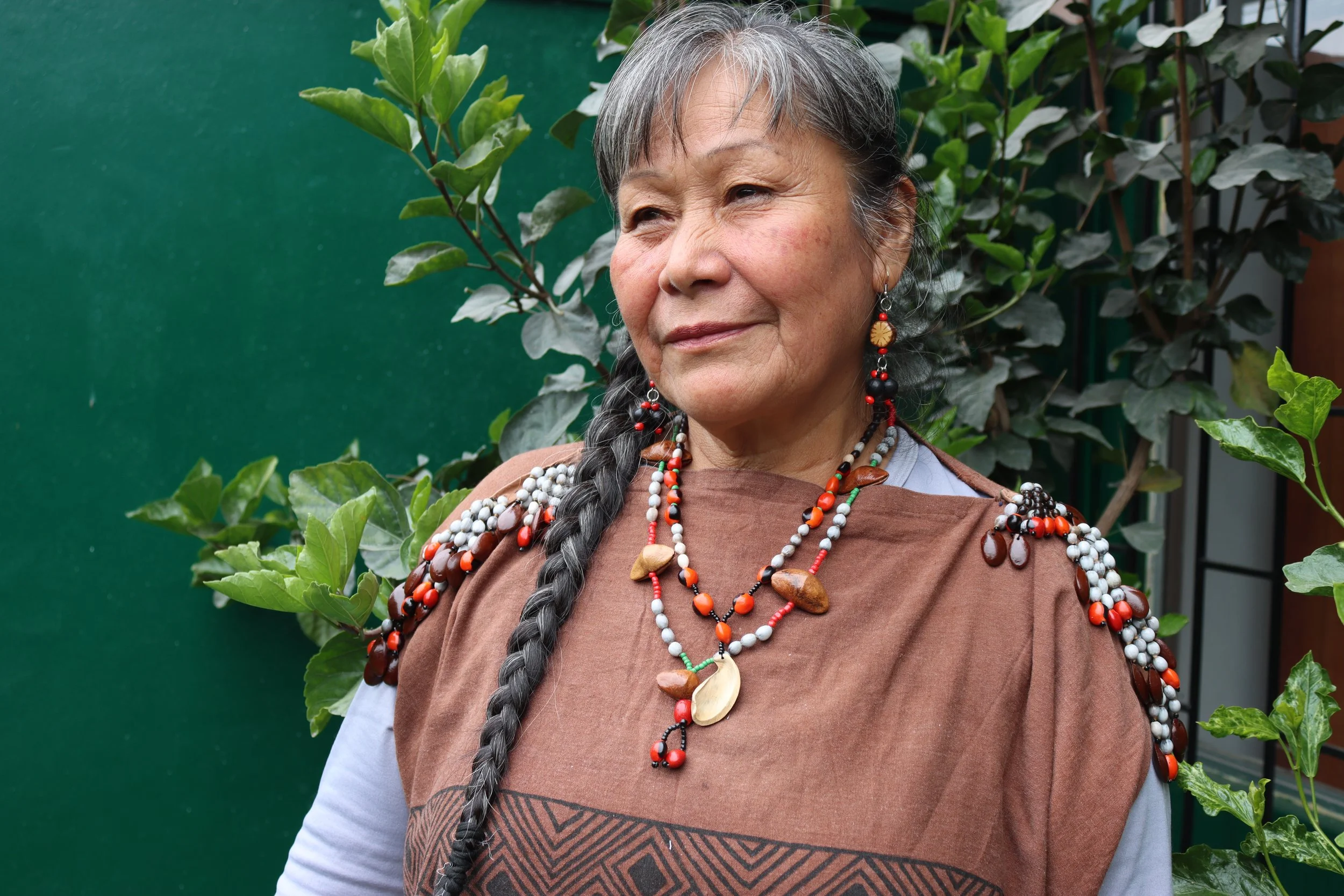‘The answer is us:’ Amazonian women at COP30 say protecting forests is about more than just money
In the Brazilian city of Belém, where the air is warm and thick and mango trees tower over the streets, one message cut through the clamor of official speeches at this year’s COP30 climate summit: “The answer is us.”
Indigenous people from Brazil and across the world gathered at the annual conference to highlight their role in protecting forests, wildlife, and water — and in confronting the climate crisis.
“My family has always preserved our territory,” said Diana Chávez, a Kichwa woman from Pastaza in the Ecuadorian Amazon. Her home is near a river with clear water shimmering over large stones, its banks dotted with guadúas – a type of tropical bamboo. “There’s a spot where you can see the whole landscape, and it’s so beautiful [that] it always makes me want to cry. This is what I’m fighting for.”
Yet she worries about the future. More people are entering her area to hunt because wildlife has disappeared elsewhere, while oil and mining projects move closer to her territory.
This year’s UN climate summit — branded the ‘Forest COP’ because of its Amazon location and planned emphasis on forests — ended without a concrete roadmap away from deforestation. But it did unlock more billions of dollars of forest-related finance. Brazil launched the Tropical Forests Forever Facility (TFFF), aiming to mobilize $125 billion to reward tropical forest countries for protecting forests, with a share for Indigenous and local communities.
While many female Indigenous leaders from Amazonian countries who attended COP30 welcomed increased funding, they warned that funding alone is not enough to protect the forest – or to tackle the inequalities that leave Indigenous women with the heaviest burdens but the least influence.
“There’s already a web of big and small funds — and financing does help strengthen our capacities,” said Chavez, who is also head of International Affairs at Pakkiru, a Kichwa organisation focused on territorial governance. “But we also need a voice and a vote in decision-making. That’s the only way to ensure money goes where it’s actually needed.”
Mundukuru women protesting outside COP venue, by Catherine Ellis for More to Her Story
The TFFF works differently from older forest-finance efforts. Instead of acting like a typical aid program, it functions as an investment fund that gives financial returns to those who contribute to it. Twenty percent of the money sent to forest-rich countries goes directly to Indigenous peoples and local communities. Brazil helped design the fund alongside partner governments, private companies, and Indigenous organizations, including the Global Alliance of Territorial Communities. One of the Alliance’s key members is COICA, which represents more than 500 Indigenous groups across the nine Amazon countries.
Its leader, Fany Kiuru — the first woman elected to the position — stresses both the importance and difficulty of ensuring funds make it to communities. “We hope this can ensure funds are distributed responsibly, because previously excessive intermediation has meant money often gets held up and doesn’t reach its intended recipients,” said Kiuru, an Uitoto woman from La Chorrera in Colombia’s Amazonas department, once the centre of the early 20th century rubber boom where Indigenous people suffered brutal exploitation.
The UN Environment Programme estimates tropical regions need US $66.8 billion every year for forest protection, restoration, and agroforestry — yet less than one percent reaches Indigenous peoples directly. Often it goes through layers of government and NGOs. For Kiuru, climate finance is essential — but must reach women, whom she calls the “guardians” of the Amazon.
“Even as the land is degraded, women like my mother have been using their own hands to repair and regenerate it, to have rainforest again, and encourage animals to return,” she said. Trees that once bore abundant fruit now produce little, and women often walk miles to gather food, water, medicinal plants, or craft materials — increasing unpaid labour.
Illegal gold mining, logging, and drug trafficking have deepened the crisis, not only harming forest ecosystems, but creating disputes over land and resources that disproportionately affect women. Research by the Igarapé Institute found sexual violence in parts of the Brazilian Amazon to be three times higher than in other regions in the country.
“Women are often put in a completely vulnerable position. Their bodies are exploited — and sometimes used in prostitution,” Valéria Paye, director of the Podáali Fund, a Brazilian Indigenous-led initiative supporting territorial protection and women’s leadership, told More to Her Story. She says camps of men working in illicit economies create environments ripe for exploitation.
The Amazon’s sheer size, difficult terrain, and mix of languages make it hard for communities to access funding, especially when complex paperwork doesn’t match the realities of life in Indigenous territories. Paye, from the Tiriyó and Kaxuyana peoples in northern Brazil, fears the TFFF could fall into the same pattern. “Funds like this reproduce bureaucracy — and bureaucracy limits access. I still believe it’s possible to reach them, but only a small percentage.”
Paye says real progress depends on building bridges between organizations and communities — and that women are key because they carry the knowledge communities rely on, from seeds and stories to traditional healing plants.
But many fear this knowledge is disappearing. Teresita Antazú López, a Peruvian Yanesha leader and the first woman in her community to become a cornesha — its highest traditional authority — describes nature as family. “Our mother is the Earth, our forests are our brothers, the water and streams our cousins — everything is our family.”
Portrait of Teresita Antazú López, by Catherine Ellis for More to Her Story
She has witnessed profound changes in her territory. Illegal gold mining has cleared 140,000 hectares of rainforest in the Peruvian Amazon, with mercury leaking into rivers and contaminating food. Expanding farmland and cattle pastures have replaced traditional gardens, eroding biodiversity and local diets. Villages are also facing shifting rainfall, degraded soils, and growing water scarcity.
Antazú runs a project across nine regional organisations on land, forests, and climate change, working with women on ‘integrated farms’ growing fruits, yucca, plantains, seeds, and medicinal plants — just like their ancestors did. She also helps map territories and address cases of gender-based violence.
Antazú is adamant that maintaining communities’ connection to the land does not mean abandoning the fight for women’s leadership. She sits on the board of AIDESEP, one of Peru’s largest Indigenous organisations, and has spent decades breaking barriers.
“I was often called a rebel growing up,” she told More to Her Story. “My grandparents — even my parents — thought women shouldn’t be educated, shouldn’t speak, shouldn’t be in meetings.” She learned to read and write, and became the first female leader in her local organization at 18, even when her grandfather threatened to beat her.
Teresita Antazú López at COP30, by Catherine Ellis for More to Her Story
Today she sees progress with women having taken “very important steps.” Still, she says, more funding is needed to strengthen communities, protect ecosystems, and support women’s leadership.
Brazil’s COP30 hosted record numbers of Indigenous delegates — around 3,000, according to the Coordination of the Indigenous Organizations of the Brazilian Amazon. Still, Indigenous representatives say too few were included in formal negotiations.
“Our participation in decision-making must be taken into account. We have to be included in these processes,” says Ginny Alba, an Indigenous lawyer from the Piratapuyo people in Guainía, Colombia. Alba was the first Indigenous woman in a Colombian delegation at a climate conference.
For her, women’s knowledge and skills aren’t only relevant on matters related to the home or land. She says education gives women the tools they need to protect their land and speak up for their rights. “Having an academic background means we can support our communities without hiring external lawyers. We need Indigenous lawyers to defend our rights,” she said.
Land rights remain a major barrier. Many Indigenous territories do not have official legal status, which limits communities’ power to control who comes in and what happens on their land. Places with legal titles see far less deforestation, while areas without titles face much higher risks from mining, logging, and land grabbing.
In Pará, COP30’s host state, the Munduruku have long opposed industrial projects — from mining and logging to the Ferrogrão railway and the National Waterway Plan, which would widen rivers for cargo transport. During COP30, Munduruku members, including prominent land defender Alessandra Korap, blocked access to the venue in protest. This — built on years of pressure, much of it led by women — helped move the government toward announcing plans to demarcate several Indigenous territories, including Munduruku lands. The news was widely celebrated.
Many NGOs welcomed the TFFF’s vision. Global Witness called it a potential lifeline for forest protection and urged the fund to direct even more support to Indigenous peoples and local communities — especially the women who carry the burden of defending forests with limited resources. At the same time, the fund has received only US $6.6 billion in pledges toward its initial $25 billion target and its long-term goal of $125 billion, leaving a significant gap between ambition and reality.
Others remain more skeptical. The Global Forest Coalition calls it a ‘false solution,’ arguing that a price tag should not be put on the forest.
“Indigenous people should be able to build something according to their autonomous practices, not have someone impose a financial market-based scheme that continues the logic of financialising nature — using markets and forests to make money,” Valentina Figuera Martínez, Gender Justice and Forests Campaign Coordinator, told More to Her Story. “And women are always the last considered actors within the whole equation.”
As COP30 ended, Diana Chávez reminded delegates during the closing statement of the Indigenous Peoples’ Caucus, which coordinates Indigenous participation in the negotiations, that their lands cannot be treated as “sacrifice zones.” She sees climate finance as useful — but only if it protects the autonomy her community still holds.
“I cross the river and sometimes I sit and put mud on my face and feet,” Chávez said. “When my family cooks, we use the fish from the river and the leaves from the trees and make maito. That’s resistance.”
For her, funding that truly reaches communities is not about replacing the forest, but about giving them the means to protect it.




